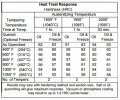The initial posting raised an issue that I have been curious about myself that I was hoping would be addressed. In the initial question one blade was brought to Rockwell 63 after quench and then tempered to 57 and the second blade was brought to Rockwell 59 and then also tempered to 57.
I have always wondered what the effects on grain structure and performance are when the same final hardness is achieved by using higher and lower Austenitize temperatures and then compensating with tempering temperatures to achieve the same final hardness. From my limited knowledge I understand higher Austenitizing temperatures promote grain growth as does longer soak times so I would assume it would be desirable to use as low a Austenitizing temp that will get one to the desired hardness but I understand I could be completely and totally wrong which is why Im asking, LOL.
I asked this question because often multiple Austenitizing temperatures are recommended in datasheets and I wonder the consequences of using higher or lower. This chart is from Crucible for CPM-154. As you can see if one wanted a reading of Rockwell 60 one could achieve it by either Austenitizing at 2000°F and tempering at 600°F or Austenitizing at 1900°F and tempering at 400°F.

Assuming the same equipment and techniques were used other than the different Austenitizing and tempering temperatures to achieve the same final hardness my question is what would be the difference in grain structure or size and how would that differentiate itself in performance if any.
And if anybody would like to comment further if one were using a stock removal method and for the sake of continuity on CPM154 what would also be the optimal total heat treatment regiment? I ask this because I have heard a lot about things like grain refinement steps, heat cycling, normalizing and multiple quenching to improve grain structure and size and I wonder if that improves performance when doing stock removal or only with forging?
I find myself fascinated by the whole process of heat treating and I won't send knives out to be professionally heat-treated because I feel mastering heat treating is a major part of knife making and I would rather make some subpar knives along the way and have sole proprietorship of my craft with the goal of eventually being a competent heat treater. Obviously that is just my approach and I respect those who differ.
I have taken Stacys advice on starting simple and buying better equipment as one understands what is really needed and I know my next purchase despite the cost has to be a Rockwell hardness tester because without it I am assuming I am getting the results I am after but I dont really know. Also after that I will be getting a real programmable oven.

